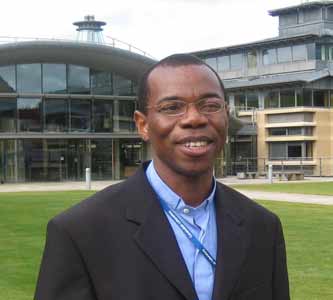 Andrew E. Ekpenyong, Ph.D.Creighton UniversityAndrew E. Ekpenyong, Ph.D., an assistant professor of physics at Creighton, is co-first author on the collaboratively published paper, titled “Actin polymerization as a key novel innate immune effector mechanism to control salmonella infection.” The paper explains how cells contain infectious diseases and opens up new options for disease management and treatment. Ekpenyong worked with a team of researchers based out of the University of Cambridge, in the United Kingdom, and the Technical University of Dresden, in Germany.
Andrew E. Ekpenyong, Ph.D.Creighton UniversityAndrew E. Ekpenyong, Ph.D., an assistant professor of physics at Creighton, is co-first author on the collaboratively published paper, titled “Actin polymerization as a key novel innate immune effector mechanism to control salmonella infection.” The paper explains how cells contain infectious diseases and opens up new options for disease management and treatment. Ekpenyong worked with a team of researchers based out of the University of Cambridge, in the United Kingdom, and the Technical University of Dresden, in Germany.
The study has shown, for the first time, that while bacterial infections evolve, the body’s cells are also evolving to fend off infection. Looking at salmonella’s behaviors both in laboratory work and in mice, Ekpenyong and his colleagues determined the mice’s cells were using physical properties to slow down the infection. It had previously been thought that once salmonella penetrated a cell’s defenses, it took up residence in a vacuole in the cell until the cell’s death. This latest observation, Ekpenyong said, shows the cell actually puts up stiffer resistance, slowing the infection and keeping it from spreading so quickly to more cells. The new research hinges on the group’s identification of a particular molecule, a complex protein known as NLRC4, as initiator of changes in the cell's physical properties. The team also used a biophysical tool, the optical stretcher, to determine the stiffness of the cells.
“What we saw were the body’s cells changing, stiffening to fight off the infection,” said Ekpenyong, who is also a product of Creighton’s graduate school. “It’s very exciting because this was unknown before. The potential of this is that we can think of drugs that can enhance this molecule and further slow the infection.”
Ekpenyong and the other researchers on this project were at work for about four years on this study. With infectious diseases responsible for one-third of all deaths in the world each year, he’s hopeful this new discovery can lead to more treatment strategies.
“It is opening up new possibilities,” Ekpenyong said. “This might help in the fight with a broad range of bacterial infections. At the very least, it has helped us better understand how pathogens interact with cells.”



